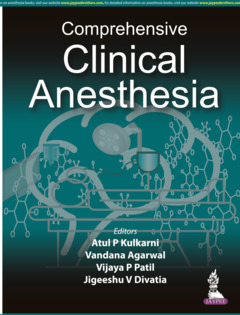Description
Comprehensive Clinical Anesthesia
Authors: Kulkarni Atul P, Agarwal Vandana, Patil Vijaya P, Divatia Jigeeshu V
Language: English
Subject for Comprehensive Clinical Anesthesia:
Approximative price 86.50 €
In Print (Delivery period: 14 days).
Add to cart682 p. · 21.5x27.9 cm · Paperback
Description
/li>Contents
/li>Biography
/li>
This book is a comprehensive guide to clinical anaesthesia for practitioners and trainees.
Divided into eleven sections, the text begins with a general overview, followed by discussion on anaesthesia delivery systems, monitoring, and equipment. A complete section is dedicated to different drugs used in anaesthesia.
The next section covers anaesthesia for different types of surgeries in various body systems. The remaining chapters detail more subspecialty-specific anaesthesia including cardiac, obstetric, neuro, paediatric, transplant, and regional.
The book concludes with a section on postoperative care.
Authored by highly experienced experts in the field, the text is further enhanced by illustrations and figures to assist learning.
Key points
- Comprehensive guide to clinical anaesthesia for practitioners and trainees
- Covers numerous types of anaesthesia for different surgeries and body systems
- Includes sections on pharmacology and postoperative care
- Highly experienced, expert author team
Section 1: ESSENTIALS FOR THE ANESTHETIST
- Landmarks in the Evolution of Anesthesia
- Patient and Personnel Safety in the Operation Theater
- Minimizing Errors in the Operating Theaters and PACU
- Quality Indicators in Anesthesia
- Soft Skills (Nontechnical Skills) and Anesthesiologist
- Research and Statistics for the Anesthesiologist
- Strategies to Improve Postoperative Outcomes
- Preanesthesia Evaluation
- Physics for Anesthetists
- Ethics and Law in Anesthesia
Section 2: ANESTHESIA DELIVERY SYSTEMS, MONITORING AND OTHER EQUIPMENT
- Modern Anesthesia Delivery Systems
- Oxygen Therapy Devices and Anesthesia Breathing Circuits
- Hemodynamic and Respiratory Monitoring
- Monitoring Neuromuscular Blockade and Reversal
- Monitoring Coagulation and Anticoagulation
- Role of Ultrasound in Anesthesia
Section 3: PHARMACOLOGY ESSENTIALS FOR THE ANESTHETIST
- Basic Pharmacology for Anesthetists
- Premedication in Anesthesia Practice
- Intravenous Anesthetic Agents
- Inhaled Anesthetic Agents
- Opioids Analgesics and Reversal Agents
- Nonopioid Analgesics
- Neuromuscular Blocking Agents and Reversal Agents
- Vasoactive Drugs in Anesthesia and Critical Care
- Drugs for Local and Regional Anesthesia
- Antisepsis in Anesthesia Practice
- Adjunct Drugs in Anesthesia
Section 4: ANESTHESIA MANAGEMENT
- Airway Management
- Anesthesia for Noncardiac Surgery in Patients with Cardiovascular Morbidity
- Anesthesia for Noncardiac Thoracic Surgery
- Anesthesia for Nonthoracic Surgery in Patients with Respiratory Morbidity
- Anesthesia for Genitourinary Surgery
- Anesthesia for Patients with Hepatic Disorders for Liver Resection and Other Surgeries
- Anesthesia for Head and Neck Surgeries
- Anesthetic Management of Patients with Diabetes Mellitus
- Anesthetic Concerns in Patients with Endocrine Disorders
- Anesthesia for Laser Surgery of the Airway
- Anesthesia for Ophthalmic Surgery
- Principles of Anesthesia for Patients with Trauma
- Anesthesia for Cancer Surgery
- Anesthesia for Vascular Surgery
- Anesthesia for the Elderly
- Anesthesia for Obese Patients
- Anesthesia for Patients with Burns
- Anesthesia for Day-care Surgery
- Anesthesia in Remote Locations
- Anesthesia for Emergency Surgery
- Anesthesia Management of a Patient with Sepsis
- Management of Common Complications during Anesthesia
Section 5: CARDIAC ANESTHESIA
- Anesthesia for Patients Undergoing Coronary Artery Bypass Grafting
- Anesthesia for Patients Undergoing Valvular Heart Surgery
- Anesthesia for Patients Undergoing Congenital Heart Surgery
Section 6: NEUROANESTHESIA
- Neuromonitoring
- Anesthesia for a Patient with Traumatic Brain Injury
- Anesthesia for Patients Undergoing Brain Tumor Surgery
Section 7: OBSTETRIC ANESTHESIA
- Labor Analgesia
- Anesthesia for Cesarean Section
- Anesthesia for the High-risk Parturient
Section 8: PEDIATRIC ANESTHESIA
- Anesthesia for Neonatal Emergencies
- Preoperative Evaluation, Preparation, Induction, Maintenance, and Emergence from Anesthesia in Children
- Perioperative Fluid and Transfusion Therapy in Children
Section 9: ANESTHESIA FOR TRANSPLANT SURGERY
- Anesthesia for Renal Transplant
- Anesthesia for Liver Transplantation
- nesthesia for Multivisceral and Intestinal Transplant
- Anesthesia for Heart Transplant
- Anesthesia for Lung Transplantation
Section 10: REGIONAL ANESTHESIA
- Neuraxial Blocks
- Upper and Lower Limb Blocks
- Chest Wall Interfascial Plane Blocks
- Abdominal Interfascial Plane Block
Section 11: POSTOPERATIVE CARE
- Management of Patients in Postanesthesia Care Unit
- Management of Complications after Anesthesia
- Temperature Management in Perioperative Period
- Cardiopulmonary Resuscitation
- Massive Blood Transfusion and Management of Complications
- Mechanical Ventilation in the Postsurgical Patient
- DVT Prophylaxis and Management of PE in the Postoperative Patient
- Perioperative Nutrition
- Acute Pain Management
- Principles of Chronic Pain Management and Palliative Care
Atul P Kulkarni MD FISCCM PGDHHM FICCM
Professor and Head, Division of Critical Care
Vandana Agarwal MD FRCA
Professor
Vijaya P Patil MD Dip
Professor and Head, Division of Clinical Anesthesia
Jigeeshu V Divatia MD FISCCM FICCM
Professor and Head
All at Department of Anesthesiology, Critical Care and Pain, Tata Memorial Hospital, Homi Bhabha National Institute, Mumbai, Maharashtra, India




